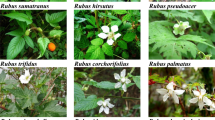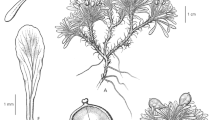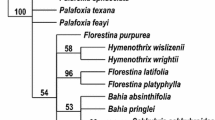Abstract
We present a comprehensive phylogeny derived from nuclear ribosomal DNA (nrDNA) for 214 samples representing 98 species and five varieties, including 44 species and five varieties native to China. Our collection of 25 species and five varieties (44 samples) covering all five sections of the genus (Comber) distributed in China also were included in the internal transcribed spacer (ITS) database. This study incorporates previous research with an emphasis on Chinese species, including the controversial subsection, Sinomartagon 5c Comber. In the phylogenetic tree obtained by maximum parsimony (PAUP) and maximum likelihood (RAxML) analyses, the samples were divided into four major groups. Our results suggest that the subsection (subsect.) 5c Comber should be classified into the true subsect. 5c and the section (sect.) Lophophorum. And the latter was divided into three subsections (subsect. Lophophorum I, subsect. Lophophorum II, and subsect. Lophophorum III). Based on molecular phylogenetic analysis and fluorescence in situ hybridization, we report that L. henryi and L. rosthornii are closely related, and we propose their classification into subsect. Leucolirion 6a. Our results support Comber’s subdivision of sect. Leucolirion, which was primarily based on bulb color. Chinese species were divided into five sections: sect. Martagon, sect. Archelirion, sect. Leucolirion, sect. Sinomartagon, and sect. Lophophorum. These findings contribute to our understanding of the phylogeny, origin, and classification of Lilium.





Similar content being viewed by others
References
Asano Y (1986) A numerical taxonomic study of the genus Lilium in Japan. J Fac Agr Hokkaido Univ 62:333–341
Baker JG (1871) A new synopsis of all the known lilies. Gardeners’ Chron Agric Gazette 28:104
Barba-Gonzalez R, Ramanna MS, Visser RGF, Van Tuyl JM (2005) Intergenomic recombination in F1 lily hybrids (Lilium) and its significance for genetic variation in the BC1 progenies as revealed by GISH and FISH. Genome 48:884–894. doi:10.1139/G05-057
Comber HF (1949) A new classification of the genus Lilium. Lily Year Book RHS 13:86–105
De Jong PC (1974) Some notes on the evolution of lilies. N Am Lily Year Book 27:23–28
Dubouzet JG, Shinoda K (1999a) ITS DNA sequence relationships between Lilium concolor Salisb, L. dauricum Ker-Gawl and their putative hybrid, L. maculatum Thunb. Theor Appl Genet 98:213–218
Dubouzet JG, Shinoda K (1999b) Phylogenetic analysis of the internal transcribed spacer region of Japanese Lilium species. Theor Appl Genet 98:954–960
Endlicher SL (1836) Genera Plantarum. F. Beck, Vienna
Fay MF et al (2006) Phylogenetic of Liliales: summarized evidence from combined analyses of five plastid and one mitochondrial loci. Aliso 22:559–565
Gao YD et al (2009) Karyotypes of four genera in Liliaceae (s.str.) from Hengduan Mountains of southwest China. Acta Bot Yunnan 31:399–405
Gao YD, Zhou SD, He XJ (2011) Karyotype studies in thirty-two species of Lilium (Liliaceae) from China. Nord J Bot 29:746–761. doi:10.1111/j.1756-1051.2011.01069.x
Gao YD, Markus Hohenegger, Harris AJ, Zhou SD, He XJ, Wan J (2012a) A new species in the genus Nomocharis Franchet (Liliaceae): evidence that brings the genus Nomocharis into Lilium. Plant Syst Evol 298:69–85. doi:10.1007/s00606-011-0524-1
Gao YD, Zhou SD, He XJ, Wan J (2012b) Chromosome diversity and evolution in tribe Lilieae (Liliaceae) with emphasis on Chinese species. J Plant Res 125:55–69. doi:10.1007/s10265-011-0422-1
Gerlach WL, Bedbrook JR (1979) Cloning and characterization of ribosomal RNA genes from wheat and barley. Nucleic Acids Res 7:1869–1885
Hall TA (1999) BioEdit: a user-friendly biological sequence alignment editor and analysis program for Windows 95/98/NT. Nucleic Acid Symposium Series 41: 95–98
Harrison GE, Heslop-Harrison JS (1995) Centromeric repetitive DNA sequences in the genus Brassica. Theor Appl Genet 90:157–165
Haw SG (1986) The lilies of China. BT Batsford Ltd, London
I˙kinci N, Oberprieler C, Gu¨ner A (2006) On the origin of European lilies: phylogenetic analysis of Lilium section Liriotypus (Liliaceae) using sequences of the nuclear ribosomal transcribed spacers. Willdenowia 36:647–656. doi:10.3372/wi.36.36201
Lee JS, Lee PO, Lim YP, Shin EM, Park SY (1996) Classification of lilies using random amplified polymorphic DNA (RAPD) analysis. Acta Hort 414:137–144
Lee CS, Kim SC, Yeau SH, Lee NS (2011) Major lineages of the genus Lilium (Liliaceae) based on nrDNA ITS sequences, with special emphasis on the Korean species. J Plant Biol 54:159–171. doi:10.1007/s12374-011-9152-0
Liang SY (1980) Flora reipublicae popularis sinicae. Anagiospermae, Monocotyledoneae Liliaceae (I), vol 14. Science Press, Beijing, pp 116–157
Liang SY, Tamura M (2000) In: Wu ZY, Raven PH (eds) Flora of China, vol 24. Science Press/Missouri Botanical Garden Press, Beijing/St. Louis, pp 118–152
Liang SY, Zhang WX (1984) Pollen tetrads in Lilium with a discussion on the delimitation between L.sempervivoideum and its ally. Acta Phytotaxonomica Sinica 22:297–300
Light RW (1960) Cytological and interspecific hybridization studies in Lilium L. and their significance for classification. Thesis: (Ph. D.) Cornell University
McRae EA (1998) Lily species. In: Lilies. Timber Press, Portland, pp 105–204
Mitchell RM (1998) Species DNA research report. The NALS Quarterly Bulletin 52:8–9
Muratović E, Bogunić F, Šoljan D, Siljak-Yakovlev S (2005) Does Lilium bosniacum merit species rank? A classical and molecular-cytogenetic analysis. Plant Syst Evol 252:97–109
Muratović E, Robin O, Bogunić F, Šoljan D, Siljak-Yakovlev S (2010) Karyotype evolution and speciation of European lilies from Lilium sect. Liriotypus. Taxon 59:165–175
Nishikawa T, Okazaki K, Uchino T, Arakawa K, Nagamine T (1999) A molecular phylogeny of Lilium in the internal transcribed spacer region of nuclear ribosomal DNA. J Mol Evol 49:238–249
Nishikawa T, Okazaki K, Arakawa K, Nagamine T (2001) Phylogenetic analysis of section Sinomartagon in genus Lilium using sequences of the internal transcribed spacer region in nuclear ribosomal DNA. Breed Sci 51:39–46
Page RMD (1996) Treeview: an application to display phylogenetic trees on personal computers. Comput Appl Biosci 12:357–358
Patterson TB, Givnish TJ (2002) Phylogeny, concerted convergence, and phylogenetic niche conservatism in the core Liliales: insights from rbcL and ndhF sequence data. Evolution 56:233–252. doi:10.1111/j.0014-3820.2002.tb01334.x
Peterson A, Peterson J (1999) Genotypic differentiation on an individual level in Gagea villosa (M. Bieb.) Duby, Gagea lutea (L.) Ker-Gawler and Gagea bohemica subsp. saxatilis (Koch) Pascher in Saxony-Anhalt using RAPD markers. J Appl Bot 73:228–233
Peterson A, Bartish IV, Peterson J (2002) Genetic structure detected in a small population of the endangered plant Anthericum liliago L. (Anthericaceae) by RAPD analysis. Ecography 25:677–684
Peterson A, John H, Koch E, Peterson J (2004) A molecular phylogeny of the genus Gagea (Liliaceae) in Germany inferred from non-coding chloroplast and nuclear DNA sequences. Plant Syst Evol 245:145–162
Rešetnik I, Liber Z, Satovic Z, Cigić P, Nikolić T (2007) Molecular phylogeny and systematics of the Lilium carniolicum group (Liliaceae) based on nuclear ITS sequences. Plant Syst Evol 265:45–58. doi:10.1007/s00606-006-0513-y
Sealy JR (1950) Nomocharis and Lilium. Kew Bull 5:273–297
Shimizu M (1971) Lilies of Japan. Seibundo Shinko-sha, Tokyo (in Japanese)
Siljak-Yakovlev S, Peccenini S, Muratovic E, Zoldos V, Robin O, Vallés J (2003) Chromosomal differentiation and genome size in three European mountain Lilium species. Plant Syst Evol 236:165–173
Smyth DR, Kongsuwan K, Wisudharomn S (1989) A survey of C-band patterns in chromosomes of Lilium (Liliaceae). Plant Syst Evol 163:53–69
Song NH (1987) Analysis of C-banded karyotypes and chromosomal relationships of Lilium species. Ph.D. thesis, Kyungpook Natl. Univ. Daegu, Korea
Stamatakis A (2006) RAxML-VI-HPC: maximum likelihood-based phylogenetic analyses with thousands of taxa and mixed models. Bioinformatics 22:2688–2690
Stewart RN (1947) The morphology of somatic chromosomes in Lilium. Am J Bot 34:9–26
Swofford DL (2000) PAUP* 4.0: phylogenetic analysis using parsimony (* and other methods). Version 4.0 b10. Sinauer Associates, Sunderland
Synce PM (1980) Lilies. Batsford, London
Takaiwa F, Oono K, Sugiura M (1985) Nucleotide sequence of the 17S-25S spacer region from rice rDNA. Plant Mol Biol 4:355–364
Tamura K, Dudley J, Nei M, Sudhir K (2007) MEGA 4: molecular evolutionary genetics analysis (MEGA) software version 4.0. In: The Society for Molecular Biology and Evolution. Oxford University Press, UK, pp 1596–1560
Terry RG, Nowak RS, Tausch RJ (2000) Genetic variation in chloroplast and nuclear ribosomal DNA in Utah Juniper (Juniperus osteosperma, Cupressaceae): evidence for interspecific gene flow. Amer J Bot 87:250–258
Thompson JD, Gibson TJ, Plewniak F, Jeanmougin F, Higgins DG (1997) CLUSTAL-X windows interface: flexible strategies for multiple sequence alignment aided by quality analysis tools. Nucleic Acids Res 25:4876–4882
Wang FZ, Tang J (1980) Lilium L. In: Flora Reipublicae Popularis Sinicae, vol 14. Science Press, Beijing, pp 116–157
Wilson EH (1925) The lilies of Eastern Asia. Dulau, London
Woodcock HBD, Stearn WT (1950) Lilies of the world. Country Life/Scribner, London/New York
Yamagishi M (1995) Detection of section-specific random amplified polymorphic DNA (RAPD) markers in Lilium. Theor Appl Genet 91:830–835
Zhou SD (2008) The phylogenetic classification and evolution of trib. Lilieae (Liliaceae s.str.) in China. PhD thesis, Sichuan Univ
Acknowledgments
This research was supported by the National Natural Science Foundation of China (Project No. 31071819), the Fundamental Research Funds for the Central Universities (Project No. BLYJ201207), special Fund for Forestry Scientific Research in the Public Interest (Project No. 201204609). We express our gratitude to Prof Shi-liang Zhou and Dr. Wen-pan Dong for providing technical assistance (LSEB Lab, Institute of Botany, Chinese Academy of Sciences), Prof. Shou-yu Guo and Dr. Qing Ding (Chinese Academy of Microbiology) for their suggestions on the earlier version and improving the English of this manuscript.
Author information
Authors and Affiliations
Corresponding author
Additional information
Y. Du and H. He contributed equally to this work.
Rights and permissions
About this article
Cite this article
Du, Yp., He, Hb., Wang, Zx. et al. Molecular phylogeny and genetic variation in the genus Lilium native to China based on the internal transcribed spacer sequences of nuclear ribosomal DNA. J Plant Res 127, 249–263 (2014). https://doi.org/10.1007/s10265-013-0600-4
Received:
Accepted:
Published:
Issue Date:
DOI: https://doi.org/10.1007/s10265-013-0600-4




